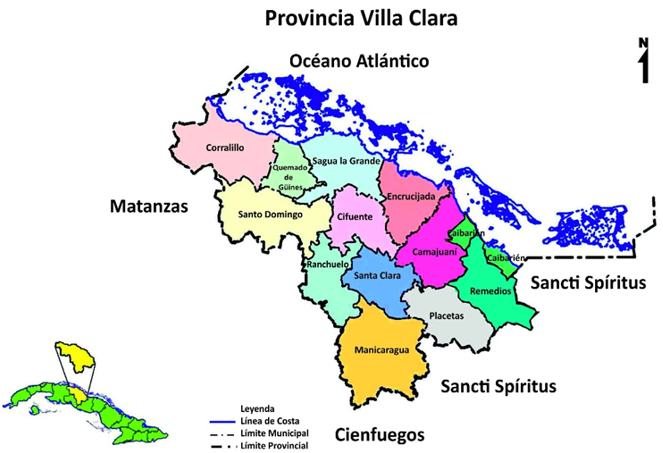Modeling of coastal floods in the town of Caibarién for climate change scenary
Main Article Content
Abstract
The present work has the purpose of simulating the coastal flooding generated by Hurricane Irma in Caibarién for the 2050 climate change scenary with a mean sea level rise of 29 cm and the 2100 scenary with a sea rise of 95 cm. For this, the coupled modeling of ADCIRC+SWAN was carried out in an unstructured computation grid that includes the coasts from Villa Clara to Camagüey and part of the Sabana – Camagüey archipelago. From this model run, the hydraulic curve of the flood was obtained, which presented a maximum of 1.97 m at 45 hours of running. The LISFLOOD-FP model was used to determine the extent of the coastal flooding in the city, which could be visualized using QGIS as a Geographic Information System. The modeling gave as a result that for the 2050 scenary, approximately 30 % of the city will be affected, while for the 2100 scenary, the affectation will be approximately 50 %. The area with the greatest vulnerability and risk turned out to be that where the city's boardwalk is located, as well as other buildings of economic and social importance.
Downloads
Article Details

This work is licensed under a Creative Commons Attribution-NonCommercial 4.0 International License.
Those authors who have publications with this journal accept the following terms of the License Attribution-NonCommercial 4.0 International (CC BY-NC 4.0):
You are free to:
- Share — copy and redistribute the material in any medium or format
- Adapt — remix, transform, and build upon the material
The licensor cannot revoke these freedoms as long as you follow the license terms.
Under the following terms:
- Attribution — You must give appropriate credit, provide a link to the license, and indicate if changes were made. You may do so in any reasonable manner, but not in any way that suggests the licensor endorses you or your use.
- NonCommercial — You may not use the material for commercial purposes.
- No additional restrictions — You may not apply legal terms or technological measures that legally restrict others from doing anything the license permits.
The journal is not responsible for the opinions and concepts expressed in the works, they are the sole responsibility of the authors. The Editor, with the assistance of the Editorial Committee, reserves the right to suggest or request advisable or necessary modifications. They are accepted to publish original scientific papers, research results of interest that have not been published or sent to another journal for the same purpose.
The mention of trademarks of equipment, instruments or specific materials is for identification purposes, and there is no promotional commitment in relation to them, neither by the authors nor by the publisher.
References
CITMA (2020). Tercera Comunicación Nacional a la Convención Marco de las Naciones Unidas sobre Cambio Climático. Ministerio de Ciencia, Tecnología y Medio Ambiente, La Habana.
CITMA (2021). Proyecciones Tarea Vida 2021-2025. Ministerio de Ciencia, Tecnología y Medio Ambiente.
IPCC (2018). Intergovernmental Panel on Climate Change. Summary for Policymakers. Printed October 2018 by the IPCC, Switzerland.
ONEI (2021). Anuario Estadístico Villa Clara Caibarién 2020, Edición 2021, Oficina Nacional de Estadística e Información Municipio Caibarién.
Pérez López, O. E., Casals, R., Pérez Parrado, R., Ortega, F. E., Pérez Osorio, P. J., Menéndez, L., Parra, L., Hernández, N., Rodríguez, N., Carracedo, D., Sánchez, B., Deus, C. (2021). Modelación numérica de inundaciones costeras por cambio climático en asentamientos seleccionados. Macroproyecto Escenarios de Peligro y Vulnerabilidad de la zona costera cubana ante el ascenso del nivel medio del mar para los años 2050 y 2100, 99 pp.
Pérez Parrado, R. (2019). Ascenso del nivel del mar en Cuba por Cambio Climático. Revista Cubana de Meteorología. Vol. 25, No.1, 76-83.
Stocker, T., Qin, D., Plattner, G. (2013). Climate change 2013: the physical science basis. Contribuition of Working Group I to the Fifth Assessment Report of the Intergovernmental Panel on Climate Change. Cambridge University Press, New York.

